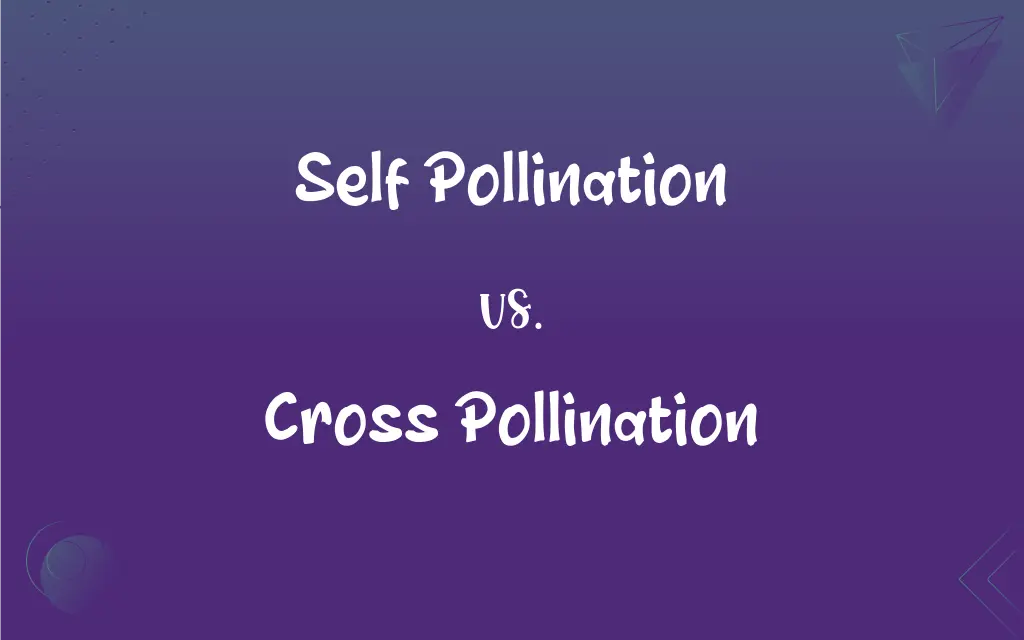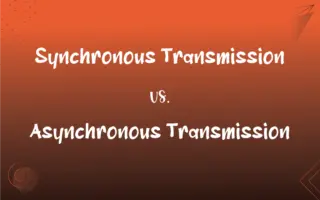Self Pollination vs. Cross Pollination: What's the Difference?
Edited by Aimie Carlson || By Harlon Moss || Updated on October 13, 2023
Self-pollination involves the transfer of pollen within the same flower or plant, ensuring genetic uniformity, while cross-pollination involves pollen transfer between different plants, promoting genetic diversity.

Key Differences
In self-pollination, pollen grains from the anther of a flower are transferred to the stigma of the same flower or a different flower on the same plant. This internal pollen transfer doesn’t require external agents like wind, water, or pollinators to be effective. Conversely, cross-pollination necessitates the transfer of pollen from the anther of a flower to the stigma of a flower on a different plant, fostering genetic diversity and variation within a plant population.
The genetic consistency found in offspring through self-pollination is both its strength and weakness. On one side, it ensures that advantageous traits are preserved across generations. On the opposite end, cross-pollination contributes to the genetic variability that enables plant species to adapt to evolving environments, resist pests, and counter diseases, providing a broadened genetic base and improved adaptability.
Self-pollination tends to secure seed production, particularly in isolated or controlled environments where cross-pollinating agents might be scarce. In stark contrast, cross-pollination, relying heavily on vectors like animals, wind, or water, connects distant individuals within a species, enhancing the gene pool and fostering robust populations through the exchange of diverse genetic material.
Plants adapted to self-pollination often have mechanisms to ensure successful pollen transfer within the same flower or between flowers of the same plant, such as contained flower structures. Alternatively, cross-pollination is characteristic of plants with flowers that are often more showy, colorful, and fragrant to attract pollinators, hence they possess features that appeal to agents like bees, birds, and butterflies, ensuring that pollen is transferred between distinct individuals.
In terms of evolutionary perspective, self-pollination can be considered a more primitive and secure reproductive strategy, ensuring procreation even in solitary conditions. Cross-pollination, though it may be deemed as a more advanced and somewhat risky strategy due to its dependency on external agents, opens a vast arena of genetic recombination and diversity, which is pivotal for the evolution and survival of species in fluctuating environmental conditions.
ADVERTISEMENT
Comparison Chart
Genetic Result
Genetic uniformity
Genetic diversity
Agents Required
Typically does not require pollinators
Requires pollinators or environmental factors
Flower Characteristics
Often smaller, less showy flowers
Larger, often colorful and fragrant flowers
Reproductive Assurance
High assurance of seed production
Less assured, dependent on external factors
Evolutionary Aspect
Considered a primitive strategy
Seen as an evolved strategy, promoting adaptation
ADVERTISEMENT
Self Pollination and Cross Pollination Definitions
Self Pollination
Self-pollination involves the transfer of pollen within the same flower or between flowers of the same plant.
The pea plant often undergoes self-pollination, maintaining a consistent genetic lineage.
Cross Pollination
In biology, a mechanism promoting genetic diversity by combining the genes of two separate individuals within a species.
Cross pollination in the wildflower population led to a vibrant array of colors and patterns in the meadow.
Self Pollination
Self-pollination ensures genetic consistency across generations of a plant.
Through self-pollination, the heirloom tomato plant preserved its desirable traits over numerous generations.
Cross Pollination
A hybridization technique where pollen is taken from one species or variety and transferred to another.
The gardener used cross pollination to create a new, robust variety of roses by mixing the traits of two existing types.
Self Pollination
Self-pollination often involves plants with floral structures that facilitate internal pollen transfer.
The violet, capable of self-pollination, possesses a floral mechanism that ensures pollen moves easily from anther to stigma within its own blossom.
Cross Pollination
The sharing or blending of ideas, cultures, or technologies between different fields or groups.
The artist experienced cross pollination of ideas by merging classical music and modern visual art in his work.
Self Pollination
Self-pollination provides a secure reproductive strategy, especially in isolated or controlled environments.
Self-pollination enabled the orchid, secluded in a greenhouse, to produce viable seeds without external intervention.
Cross Pollination
In business, the practice of integrating strategies or products from different sectors to innovate.
The tech company found success through cross pollination, incorporating ideas from the healthcare sector into its software development.
Self Pollination
Self-pollination can occur without the need for external pollinators or environmental factors.
Despite being grown in isolation, the bean plant produced seeds thanks to its ability for self-pollination.
Cross Pollination
The transfer of pollen from the anther of one plant to the stigma of a different plant.
The bee facilitated the cross pollination between the two distinct apple trees, promoting genetic diversity.
FAQs
How does cross pollination differ from self pollination?
Cross pollination involves the transfer of pollen between different plants, while self pollination occurs within the same plant.
Can a plant species experience both self and cross pollination?
Yes, some plants can utilize both self and cross pollination depending on environmental and biological factors.
Are there disadvantages to self pollination?
Yes, such as a lack of genetic diversity which can make the species more susceptible to diseases and adverse environmental changes.
What are some advantages of self pollination?
Advantages include a guaranteed reproduction, low energy and resource use, and consistency in offspring traits.
Can self pollination occur in wind-pollinated plants?
Yes, if pollen from a wind-pollinated plant fertilizes its own flowers or other flowers on the same plant, it is self pollination.
How does cross pollination impact crop production?
Cross pollination can create hybrid vigor, potentially improving crop yield, disease resistance, and overall performance.
What is assisted cross pollination?
Assisted cross pollination is a human-mediated transfer of pollen from one plant to another to achieve desired breeding outcomes.
Are all plants capable of cross pollination?
No, some plants are obligate self-pollinators and do not readily cross-pollinate.
What is self pollination?
Self pollination occurs when pollen from a flower fertilizes the same flower or another flower on the same plant.
Why is cross pollination important?
Cross pollination promotes genetic diversity, which can enhance survival, adaptability, and the evolution of species.
What are agents of cross pollination?
Agents of cross pollination can include wind, water, insects, birds, and animals.
What is a pollinator?
A pollinator is an agent, like a bee or wind, that moves pollen from the male anther to the female stigma of flowers.
How can cross pollination be prevented in crop production?
Techniques may include physical barriers, temporal isolation, or spatial isolation to prevent unwanted cross pollination.
Can cross pollination affect the flavor of fruits and vegetables?
Yes, cross pollination can potentially introduce new genetic combinations that alter flavor, size, color, and other traits of the produce.
How does self pollination support survival in harsh conditions?
Self pollination allows for reproduction even in the absence of pollinators or neighboring plants, aiding survival in isolated or harsh conditions.
Can self pollination occur in all plants?
No, self pollination can only occur in plants that possess both male and female reproductive organs and are self-compatible.
Does self pollination always lead to seed production?
Generally yes, but environmental and genetic factors might impact the successful development of seeds.
How is genetic diversity achieved through cross pollination?
Cross pollination combines genes from two different plants, creating offspring with a mix of traits from both parents.
Why might a gardener choose self pollinating plants?
Self pollinating plants often require fewer resources and external factors to produce viable seeds and offspring.
Can cross pollination occur between different species?
Typically, it occurs between different plants of the same species, but it can happen between different species, creating hybrids, in some cases.
About Author
Written by
Harlon MossHarlon is a seasoned quality moderator and accomplished content writer for Difference Wiki. An alumnus of the prestigious University of California, he earned his degree in Computer Science. Leveraging his academic background, Harlon brings a meticulous and informed perspective to his work, ensuring content accuracy and excellence.
Edited by
Aimie CarlsonAimie Carlson, holding a master's degree in English literature, is a fervent English language enthusiast. She lends her writing talents to Difference Wiki, a prominent website that specializes in comparisons, offering readers insightful analyses that both captivate and inform.
































































